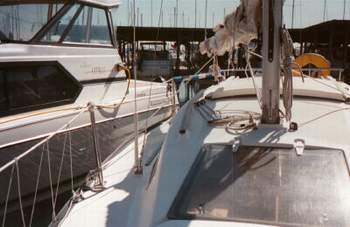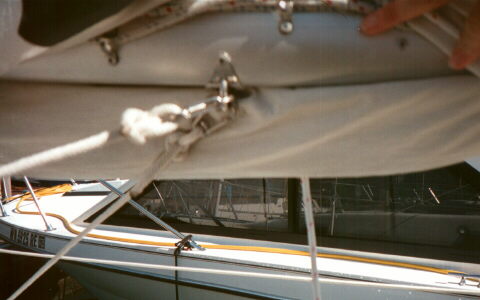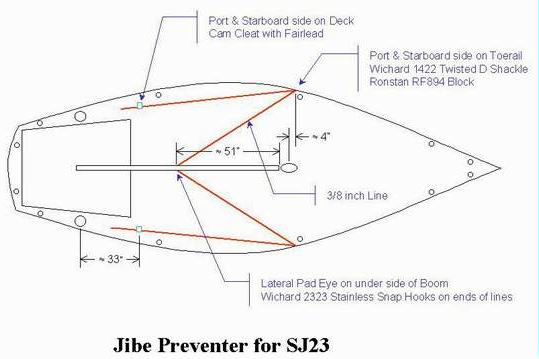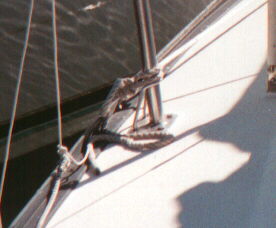| SJ23 Tech Tip F08, (Updated 2023-06-09) Art Brown, Bob Schimmel | |||||
|
Boom Jibe Preventer. |
|||||
| Banana Split, is equipped with a jibe
preventer which is a line tied to the boom to prevent it from swinging
across the cockpit, uncontrolled. This is an excellent description of an accidental jibe! Sorry, but shit happens sometimes, even with the best of crew. One can only hope that a head doesn't get bashed in. That swinging boom is a perfect recipe for a headache, to say the least. With this design it might even be possible to eliminate the vang, although it couldn't swing with the boom. In the absence of a boom brake the prescribed technique for jibing is to pull the boom to mid cockpit, jibe the boat, and release the mainsheet after the boat falls on the new heading.
Operation - Banana Split has two control lines, one to either side. Each is equipped with a cam cleat for quick release. By pulling one or both lines tight, and then securing them into their respective cam cleat, they keep the boom stationary. I think the best value is that they prevent an accidental jibe. Next, they can be used to keep the boom hard out on a downwind run. While moored or under power I frequently set each in their cleat to keep the boom stationary. Does it work well? - Yes, it is very effective in keeping the boom from swinging about when you want it to be steady, like in light air or when I find myself in the wake of some "smoke-pot"! Is it easy to use? - They are very easy to set. Just call to the "First Mate" to set the preventer and if you are in her good graces she will pull the lines tight and set them into their cam cleats. On the other hand, you can do it yourself! Is it a hindrance in any way? - Having the preventer on the boat also means there are two additional lines on the side decks to trip over. On occasion, I forget to release them when I want the boom to swing. To quote The Art and Science of Sails, "Setting a preventer has its drawbacks too, some of which can be serious." If a preventer is set when a broach occurs, the main will back fill on the wrong side. This can pin the boat down, even if the spinnaker is let go. However, the danger of not sailing with a preventer should be obvious and can be deadly. In an accidental jibe, someone might get hit by an uncontrolled boom as it makes its terrifying arc across the cockpit." Art Brown.
|
|||||
|
COMMENTS A preventer stabilizes the whole rig off the wind and if you fall or something and the boat jibes then nobody gets hurt and the main is small enough that you don't broach afterward. You can even operate the preventer from the cockpit as an emergency brake when reaching or beating. So much for the sailing part. The best reasons are when the boat is not sailing:
"I find that a single block on each toe rail is the best set up. I've talked to people who sailed the Vic-Maui race, which is
bigger water than I sail on, and they want a line that is
small enough so it can break in a hard knock down. This is on
>35' boat with serious sail area. 200 ft2 of
main, or more, and over 25 knots of wind. I have found a
1/4" or 5/16" line is fine for the Puget Sound waters and the Strait of Juan de Fuca. Last time I crossed the
Strait, I had 15 knots of wind and 7' waves on my starboard quarter
and could just barely steer with a wheel in my SJ34. If I found
myself in those conditions in a SJ23, I would run for cover and
wait until it calmed. Use a block on each toe rail and put the line on a
winch so you can ease it in a controlled manner. A boom is so
expensive. Your money is better spent on strong spirits that can embellish the story when you get to
the dock!" Gene Adams |
|||||
|
BOOM BRAKE by MeriMarine - A simple and effective version of a boom brake to prevent an inadverted jibe. It works with friction and even has a setting for high winds. Seems easy to adjust with one control line, although you could release or set either end of the control line. Click on the link for the details https://dreamgreen.org/boom-brake |
|||||
|
Return to Tech Tip Index. . . . . . . . . . . . . . . Have a Question? |
|||||



